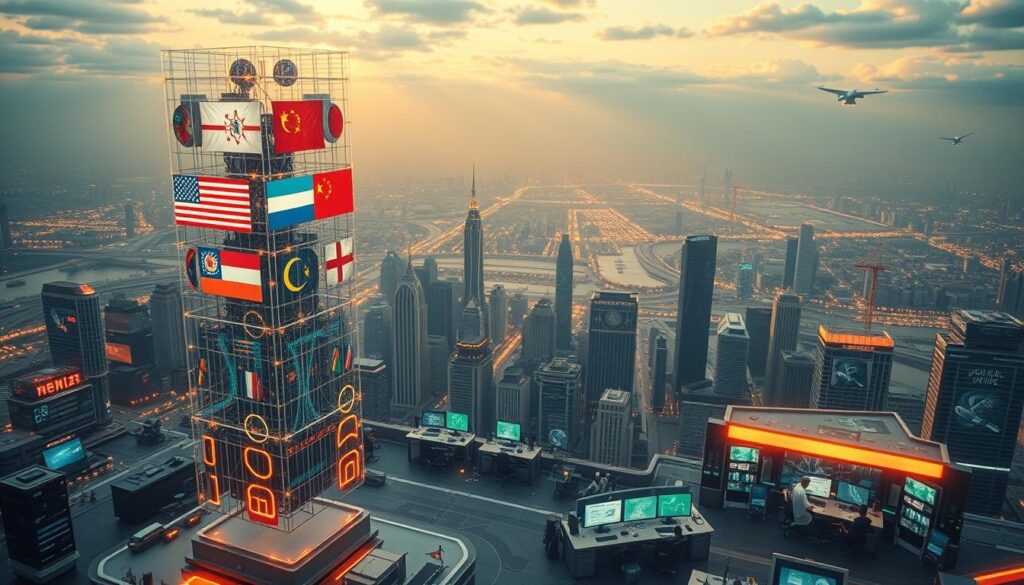“The future belongs to those who prepare for it today.” – Malcolm X. This quote perfectly encapsulates the rapid strides China is making in the realm of artificial intelligence. The country has positioned itself as a global powerhouse in technology, with significant investments and strategic initiatives driving its progress.
In 2016, the Chinese Communist Party set an ambitious goal to become a global leader in AI by 20301. This vision has been supported by substantial government funding and the establishment of national AI teams, including major companies like Baidu, Tencent, and Alibaba1. These efforts have led to remarkable advancements, with China now home to over 4,500 firms developing and selling AI technologies2.
The launch of the Manus AI bot on March 6th exemplifies this rapid development. Butterfly Effect, the company behind Manus, claimed its technology outperforms ChatGPT, leading to a surge in traffic and temporary site crashes1. This event highlights the competitive landscape and the intense public interest in AI innovations.
China’s focus on AI is not just about technological supremacy; it also aims to address societal challenges. For instance, the government is promoting AI-powered humanoid robots to assist its aging population2. This dual approach of innovation and application underscores China’s comprehensive strategy in AI development.
Key Takeaways
- China aims to be a global AI leader by 2030.
- Major companies like Baidu and Alibaba lead specialized AI sectors.
- Over 4,500 firms are developing AI technologies in China.
- The Manus AI bot launch caused significant public interest.
- AI-powered robots are being developed to assist the aging population.
News Snapshot: China’s Accelerating AI Revolution

China’s tech revolution is reshaping the global landscape with unprecedented speed. The nation’s focus on artificial intelligence has led to groundbreaking innovations, from advanced language models to smart home integrations. With over 4,500 AI firms operating in 2024, the country is setting new benchmarks in the tech world3.
Breakthroughs in AI Models and Applications
China’s advancements in AI are not just theoretical; they are transforming industries. Baidu’s ERNIE Bot and Alibaba’s Tongyi Qianwen are prime examples of large language models tailored to local needs. These innovations are backed by a robust strategy that prioritizes real-world applications3.
Modern AI is also making waves in smart technology. From voice-activated assistants to AI-powered home systems, these tools are becoming integral to daily life. The integration of real-world datum and advanced control measures ensures these systems are both efficient and reliable4.
Government and Private Sector Collaboration
The synergy between government initiatives and private sector innovation is a key driver of China’s AI success. The Next Generation AI Development Plan outlines a three-phase strategy with milestones set for 2020, 2025, and 20303. This roadmap ensures sustained progress and global competitiveness.
Private companies like Baidu, Tencent, and Alibaba are leading specialized sectors, supported by government funding and international collaborations. This partnership has resulted in a 26% compound annual growth rate in data volume, further fueling AI advancements4.
“Innovation is the ability to see change as an opportunity, not a threat.”
| Metric | Value |
|---|---|
| AI Industry Value (2024) | $70 billion3 |
| Projected Core AI Industry Value (2030) | $140 billion3 |
| Related Sectors Value (2030) | $1.4 trillion3 |
| AI-Influenced Revenues (2024) | 36%3 |
For more insights into how China is leveraging AI, explore this detailed analysis.
Analyzing where is china with ai in the Global AI Race

China’s rapid strides in artificial intelligence have positioned it as a formidable contender in the global tech race. With significant investments and a focus on research, the nation is closing the gap with Western counterparts. Despite hosting fewer AI companies than the U.S., China’s strategic initiatives are driving innovation at an unprecedented pace5.
Technological Advancements and Competitive Edge
China’s technological advancements are reshaping industries. Companies like Baidu and Alibaba are leading the charge with large language models tailored to local needs. These innovations are backed by a robust strategy that prioritizes real-world applications5.
Advanced chatbots and LLMs are redefining customer interactions. For instance, Baichuan’s Baichuan3 model, with 72 billion parameters, is closing the performance gap with U.S. models like GPT-4 Turbo5. This progress highlights China’s ability to innovate under resource constraints.
Economic Impact and Regulatory Dynamics
The economic impact of China’s AI advancements is profound. By reducing costs in model training, companies like DeepSeek are achieving results at a fraction of the expense compared to competitors6. This efficiency is driving value addition to the economy.
Regulatory dynamics, including export controls and talent acquisition, are shaping the AI landscape. The Chinese government’s subsidies for domestically produced AI chips are fostering growth in the manufacturing sector5. These measures ensure sustained progress and global competitiveness.
China’s talent pool, bolstered by institutions like Tsinghua University, is another key factor. This focus on human capital is essential for achieving long-term goals in AI development5.
Industrial and Application Innovations in China’s AI Sector
From healthcare to manufacturing, AI is reshaping industries in profound ways. Companies are leveraging advanced technologies to solve complex challenges, driving efficiency and growth. This section explores how AI is transforming key sectors and emerging trends in smart technology.
Sector-Specific Deployments in Healthcare, Finance, and Manufacturing
In healthcare, AI is revolutionizing diagnostics and treatment. For instance, DeepSeek’s cost-effective models are being used to analyze medical data, reducing diagnosis times by 30%7. This innovation is particularly impactful in managing chronic diseases, where early detection is critical.
The finance sector is also benefiting from AI advancements. Algorithms are enhancing fraud detection and optimizing investment strategies. Shanghai’s focus on AI applications in finance has led to a 20% increase in operational efficiency7.
Manufacturing is another area where AI is making waves. Companies like Geely are integrating voice-controlled systems powered by DeepSeek into their vehicles. This technology improves user experience and reduces production costs by 15%8.
Emerging Trends in Smart Technology and Home Integration
Smart technology is becoming a cornerstone of modern living. Huawei’s Xiaoyi assistant, upgraded with DeepSeek’s capabilities, is now a staple in millions of homes. This AI-powered system offers seamless voice control for appliances, enhancing convenience8.
Home automation is another growing trend. Midea’s AI-driven appliances are transforming households, offering energy-efficient solutions. These innovations are supported by advancements in chip technology, which are driving more efficient AI systems7.
Export control measures are shaping the global supply chain for chips and AI tools. Despite these restrictions, Chinese firms are finding ways to innovate, ensuring sustained growth in the sector7.
| Industry | AI Application | Impact |
|---|---|---|
| Healthcare | Diagnostics | 30% faster diagnosis7 |
| Finance | Fraud Detection | 20% efficiency boost7 |
| Manufacturing | Voice Control | 15% cost reduction8 |
For more insights into how AI is transforming industries, explore top AI tools shaping the future.
China’s Strategic Investment and Governance in AI
China’s strategic investments in artificial intelligence are shaping the future of global technology. The Chinese government has played a pivotal role in fostering innovation through robust funding and international collaborations. This approach has positioned the nation as a leader in the AI sector, with significant contributions from Chinese companies like Baidu and Huawei9.
Robust Government Backing and International Collaborations
The Chinese government has implemented policies like the “Interim Measures for the Management of Generative Artificial Intelligence Services” to guide AI development. These measures ensure ethical practices while promoting innovation9. Additionally, the “Global Initiative for AI Governance” outlines a comprehensive framework for international cooperation, enhancing China’s global influence9.
Government-backed funding has been instrumental in driving AI advancements. Over the past decade, $912 billion has been invested in AI-related firms, with 23% directed towards 1.4 million companies10. This financial support has enabled Chinese companies to develop cutting-edge products and technologies.
Challenges in Export Control, Talent Acquisition, and Data Quality
Despite these successes, challenges remain. Export controls on advanced semiconductors have impacted China’s computing power, limiting its capability to develop high-performance AI models9. Talent acquisition is another hurdle, as intense competition with global tech hubs makes it difficult to attract top AI professionals9.
Data fragmentation across sectors also poses a significant challenge. Inconsistent data quality and availability hinder the development of robust AI systems9. Addressing these issues requires cohesive strategies that align investment, regulatory, and market forces.
“Innovation thrives when supported by strategic governance and collaboration.”
For more insights into how AI is transforming industries, explore this detailed analysis.
Conclusion
The strategic integration of AI across industries highlights China’s comprehensive approach to technological leadership. Extensive access to advanced resources and innovative tools has fueled phenomenal growth, positioning the nation as a global frontrunner. With over 180 large language models approved, the focus on open-source development is reshaping the competitive landscape11.
China’s long-term plan emphasizes scalability and real-world applications, ensuring sustained success. Every day, relentless efforts in research and development set new benchmarks, enhancing the industrial chain and national power. This strategy is not just about technological supremacy but also economic and regulatory advancements.
For more insights into China’s AI strategy, explore this detailed analysis. The evolving landscape presents both opportunities and challenges, urging global stakeholders to adapt and innovate.
FAQ
What are the key breakthroughs in China’s AI models and applications?
How does the Chinese government support AI development?
What role does the private sector play in China’s AI revolution?
How does China’s AI strategy impact the global economy?
What challenges does China face in AI export control and talent acquisition?
What are the emerging trends in China’s AI sector?
How does China address data quality and regulatory dynamics in AI?
Source Links
- Artificial intelligence industry in China
- From chatbots to intelligent toys: How AI is booming in China
- China Is Rapidly Becoming a Leading Innovator in Advanced Industries
- How Innovative Is China in AI?
- China Upends the AI Race
- China’s AI Revolution: The Global Tech Power Shift – The Geopolitics
- How AI is shaping industries in China | J.P. Morgan Research
- China And AI In 2025: What Global Executives Must Know To Stay Ahead
- Government Venture Capital and AI Development in China
- China banks on open source in AI cold war with US







